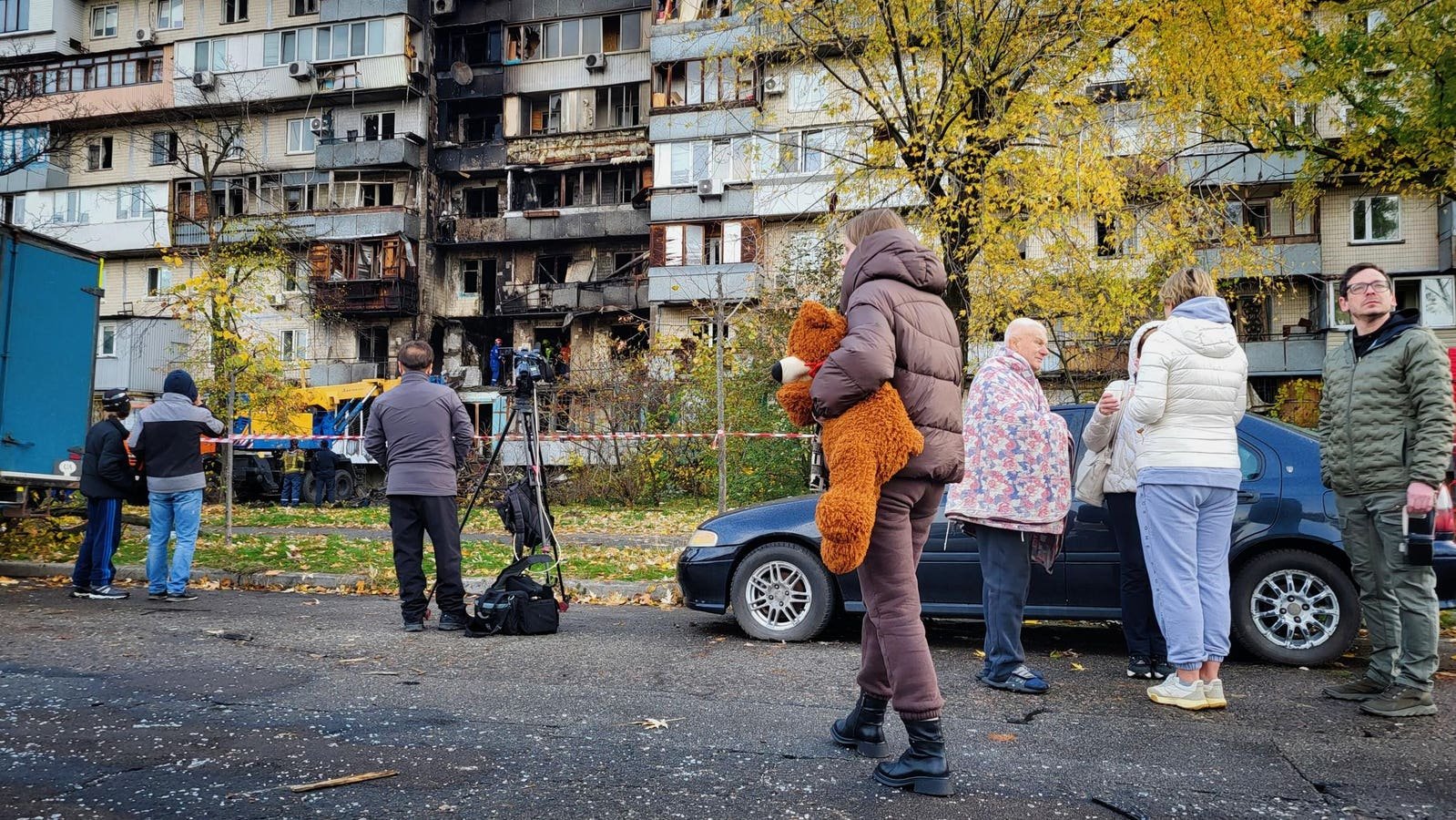KYIV, UKRAINE – OCTOBER 26: Residents gather in a yard while workers remove rubble at an apartment building hit by a Russian drone strike on October 26, 2025 in Kyiv, Ukraine. (Photo by Andriy Zhyhaylo/Oboz.ua/Global Images Ukraine via Getty Images)
Global Images Ukraine via Getty Images
Dispatches from Ukraine. Day 1,342.
Russian Attacks on Ukraine
Ukraine’s capital, Kyiv, endured two consecutive nights of Russian strikes this weekend. The latest overnight attack on Oct. 26 saw drones and ballistic missiles raining down on the city. In total, five people were killed, and more than fifty others were injured.
In other strikes between Oct. 24-27, Ukrainian officials reported at least 18 individuals killed and 83 people injured in Russian strikes. In southern Kherson oblast, or province, five civilians were killed, and in eastern Donetsk oblast, seven civilians lost their lives; 45 residents were injured across the two provinces. In southeastern Zaporizhzhia, three people were killed and seven were wounded, while in central Dnipropetrovsk, two were killed and eight were injured. Northeastern Kharkiv oblast reported one fatality and 23 residents wounded.
Ukraine’s Counterstrikes on Russia
Ukraine has also carried out significant drone strikes. Russia’s defense ministry reported shooting down 40 Ukrainian drones over the Moscow region on Oct. 27, bringing the total destroyed across the country to 193. The attacks prompted temporary flight restrictions at two of Moscow’s airports, Domodedovo and Zhukovsky southeast of the city, with several planes diverted to alternate airports.
In addition, Ukraine struck a dam in Russia’s Belgorod region over the weekend, causing structural damage at the reservoir. The attack, which was confirmed by Robert Brovdi, commander of Ukraine’s Unmanned Systems Forces, caused water levels to drop by about 40 inches. Russian footage showed water spilling through a cracked sluice gate and flooding trenches reportedly used by Russian troops; in addition, Ukrainian sources claimed the strike left several Russian units stranded and cut off from logistics along the Siverskyi Donets River, a natural barrier along the eastern frontline.
Saab Plans Fighter Jet Assembly in Ukraine
Swedish defense manufacturer Saab is reportedly preparing to open a final-assembly plant in Ukraine as part of an agreement for Kyiv to purchase up to 150 fighter jets. “It is not so easy during a war, but it would be great to set up a capacity for at least final assembly and tests and maybe part production in Ukraine,” said Saab CEO Micael Johansson. The agreement, for which financing has yet to be secured, could more than double Saab’s current production and mark one of the largest defense partnerships since Russia’s full-scale invasion.
The proposed contract follows a letter of intent signed last week between President Volodymyr Zelenskyy and Swedish Prime Minister Ulf Kristersson that outlined Kyiv’s plan to acquire 100 to 150 Gripens, a Swedish multi-role, fourth-generation fighter jet. While Ukraine has already received U.S.-made F-16s from European allies, Gripens are widely seen as better suited for Ukraine’s defense needs: these jets were designed during the Cold War to defend Sweden against potential Soviet aggression.
For Saab, the Ukrainian order would be transformative. The company has sold 60 of its latest Gripens to Sweden, 36 to Brazil, and four to Thailand. Johansson said a Ukrainian deal would “more or less double the capacity needs” for the aircraft, with Saab considering expanding production in Brazil, Canada, and Europe. Current output stands at just over half the company’s historic peak of 18 aircraft a year.
But financing remains the key hurdle. Kristersson has been discussing potential solutions with EU leaders, including using frozen Russian assets, although some countries, especially Belgium, continue to express skepticism about using Russian finances. Saab’s Johansson, however, said the political discussions are ongoing.
Zelenskyy Urges U.S. to Push Moscow to the Negotiating Table
President Volodymyr Zelenskyy is urging the U.S. to build on recent measures taken to hold Moscow accountable. “Sanctions will make a difference,” he said in an interview with Axios on Oct. 27, discussing the impact of new U.S. sanctions on Russia’s two largest oil companies, which he anticipates could cut oil exports by 50%, translating to as much as $5 billion in monthly revenue losses for the Kremlin. But “if Putin doesn’t stop,” Zelensky continued, “we need something to stop him. Sanctions is one such weapon, but we also need long-range missiles.” Zelenskyy noted that Kyiv wouldn’t even need to use them immediately; its mere the ability to strike critical targets inside Russia could push Moscow toward negotiation.
The Ukrainian leader acknowledged that an Oct. 17 meeting with President Trump, during which he requested Tomahawk missiles, was tense. But he said the two sides found common ground, most prominently thanks to Ukraine’s significant concession to ending the war: accepting Trump’s proposal to freeze the front lines as a basis for negotiations.
Zelensky also hopes Trump’s meeting with Chinese President Xi Jinping could lead to Beijing reducing its Russian oil purchases. “The strongest step is if India and China will not buy energy from Russia, first of all oil.”
On the battlefield, Zelenskyy painted a grim picture for Russia, citing an estimated 346,000 Russian soldiers killed and wounded this year alone. “Today on the battlefield, we stand mostly where we stood during these last two-to-three months,” he added.
By Danylo Nosov, Karina L. Tahiliani

